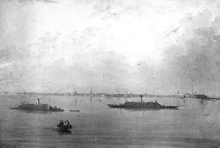CSS Palmetto State
 CSS Chicora and Palmetto State at anchor in Charleston Harbor | |
| History | |
|---|---|
| Name: | Palmetto State |
| Laid down: | January 1862 |
| Launched: | September 1862 |
| Commissioned: | September 1862 |
| Decommissioned: | February 18, 1865 |
| Fate: | Burned to prevent capture |
| General characteristics | |
| Displacement: | approximately 850 tons |
| Length: | 150 ft (46 m) |
| Beam: | 34 ft (10 m) |
| Draft: | 12 ft (3.7 m) |
| Propulsion: | Steam engine |
| Speed: | 6 knots (11 km/h; 6.9 mph) |
| Complement: | 125 officers and men |
| Armament: | 2 7" Brooke rifled cannons, 2 9" Dahlgren smooth-bore cannons |
CSS Palmetto State was an ironclad ram built in January 1862 by Cameron and Co., Charleston, South Carolina, under the supervision of Flag Officer D. N. Ingraham, CSN. She was readied for service by September 1862 when Lieutenant Commander John Rutledge, CSN, was placed in command. Her casemate armor was 4" thick, backed by 22" of wood, while 2" of iron armor was used everywhere else. Her pilothouse was not placed forward but was positioned abaft of the smokestack.
Before dawn on January 31, 1863, Palmetto State and her sister ram CSS Chicora crept through thick haze to surprise the Union blockading force off Charleston. Taking full advantage of her low silhouette in the darkness, the ironclad steamed in under the guns of USS Mercedita, ramming as well as firing heavy shot point-blank into her hull. Completely disabled, with cannon that could not be depressed low enough to fire at Palmetto State, the Union ship was forced to surrender. The ram then turned her attention to USS Keystone State, firing several shells into the blockader. Her steam chests punctured, Keystone State lost all power and had to be towed to safety. A long-range cannon duel between the Confederate rams and other Federal blockaders then took place, but little damage was inflicted by either side before Palmetto State and Chicora withdrew to safety within Charleston Harbor. The attack by the Confederate rams caused the temporary withdrawal of the blockaders from their inshore positions and led to the claim by the Confederate Government, unsuccessfully advanced, that the blockade of Charleston had been broken.
Palmetto State also joined in the defense of Charleston during Admiral Samuel Francis du Pont's unsuccessful April 1–7, 1863 attack on the harbor forts. Her officers and men were cited for rendering valuable services on the night of September 6–7, 1863 during the removal troops from Fort Wagner and Battery Gregg.
Palmetto State was later set-fire by the Confederates to avoid capture upon the evacuation of Charleston on February 18, 1865.
![]() Media related to CSS Palmetto State at Wikimedia Commons
Media related to CSS Palmetto State at Wikimedia Commons
References
- Silverstone, Paul H. (2006). Civil War Navies 1855–1883. The U.S. Navy Warship Series. New York: Routledge. ISBN 0-415-97870-X.
- Still, William N., Jr. (1985). Iron Afloat: The Story of the Confederate Armorclads (Reprint of the 1971 ed.). Columbia, South Carolina: University of South Carolina Press. ISBN 0-87249-454-3.
This article incorporates text from the public domain Dictionary of American Naval Fighting Ships.